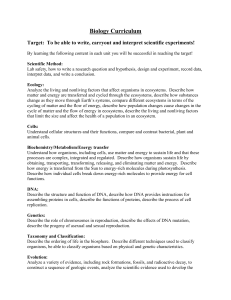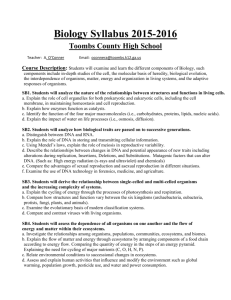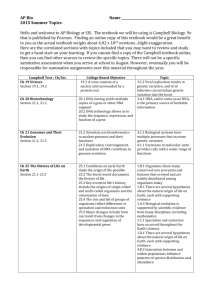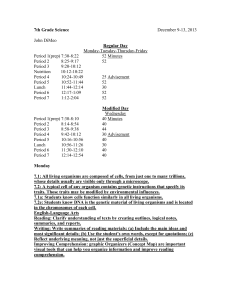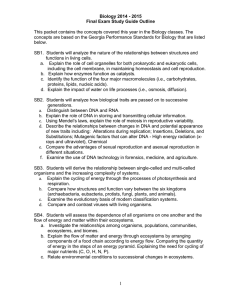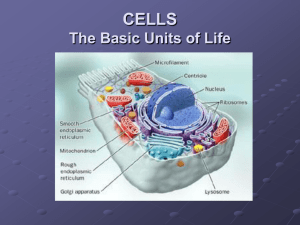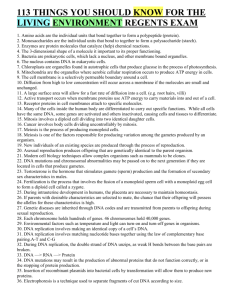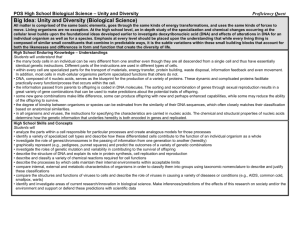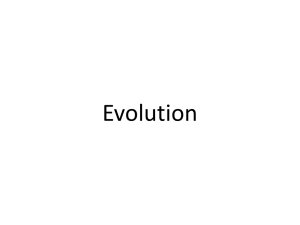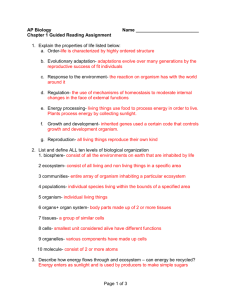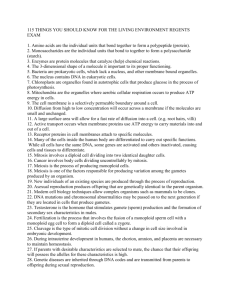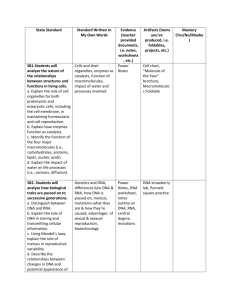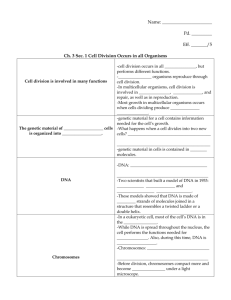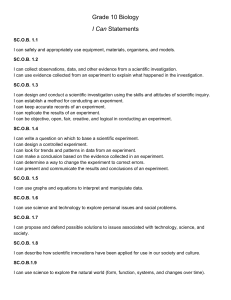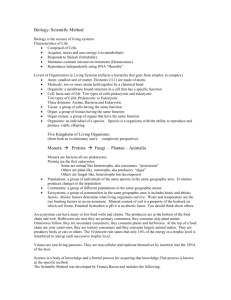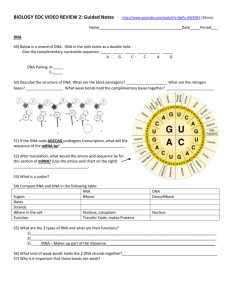Syllabus in Brief
advertisement
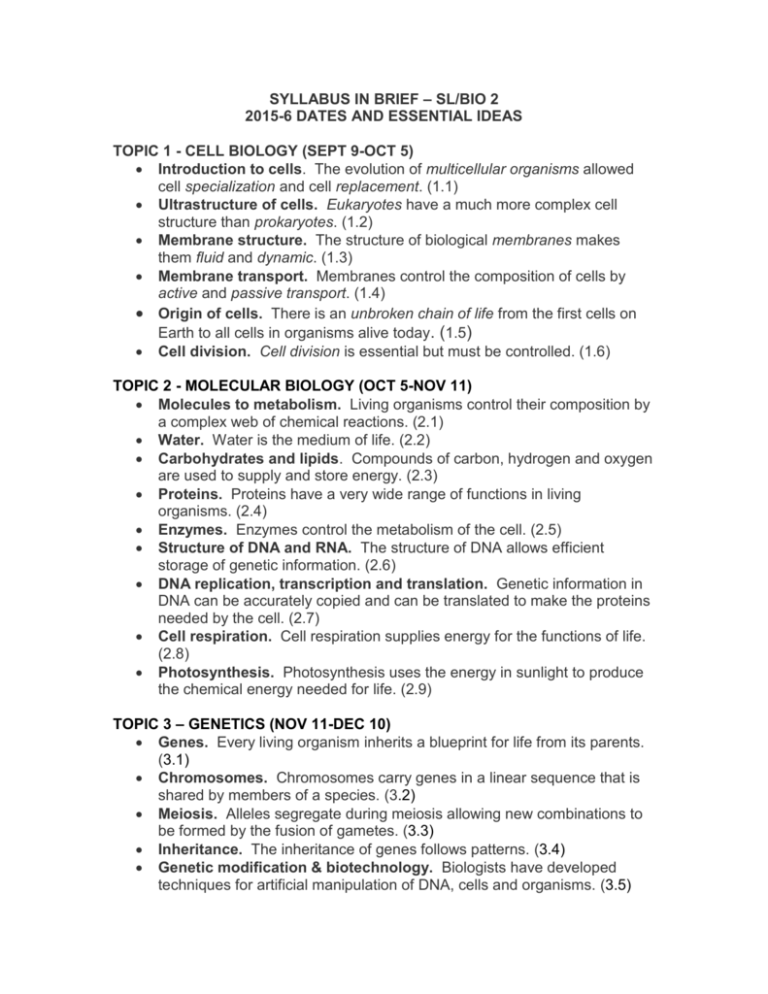
SYLLABUS IN BRIEF – SL/BIO 2 2015-6 DATES AND ESSENTIAL IDEAS TOPIC 1 - CELL BIOLOGY (SEPT 9-OCT 5) Introduction to cells. The evolution of multicellular organisms allowed cell specialization and cell replacement. (1.1) Ultrastructure of cells. Eukaryotes have a much more complex cell structure than prokaryotes. (1.2) Membrane structure. The structure of biological membranes makes them fluid and dynamic. (1.3) Membrane transport. Membranes control the composition of cells by active and passive transport. (1.4) Origin of cells. There is an unbroken chain of life from the first cells on Earth to all cells in organisms alive today. (1.5) Cell division. Cell division is essential but must be controlled. (1.6) TOPIC 2 - MOLECULAR BIOLOGY (OCT 5-NOV 11) Molecules to metabolism. Living organisms control their composition by a complex web of chemical reactions. (2.1) Water. Water is the medium of life. (2.2) Carbohydrates and lipids. Compounds of carbon, hydrogen and oxygen are used to supply and store energy. (2.3) Proteins. Proteins have a very wide range of functions in living organisms. (2.4) Enzymes. Enzymes control the metabolism of the cell. (2.5) Structure of DNA and RNA. The structure of DNA allows efficient storage of genetic information. (2.6) DNA replication, transcription and translation. Genetic information in DNA can be accurately copied and can be translated to make the proteins needed by the cell. (2.7) Cell respiration. Cell respiration supplies energy for the functions of life. (2.8) Photosynthesis. Photosynthesis uses the energy in sunlight to produce the chemical energy needed for life. (2.9) TOPIC 3 – GENETICS (NOV 11-DEC 10) Genes. Every living organism inherits a blueprint for life from its parents. (3.1) Chromosomes. Chromosomes carry genes in a linear sequence that is shared by members of a species. (3.2) Meiosis. Alleles segregate during meiosis allowing new combinations to be formed by the fusion of gametes. (3.3) Inheritance. The inheritance of genes follows patterns. (3.4) Genetic modification & biotechnology. Biologists have developed techniques for artificial manipulation of DNA, cells and organisms. (3.5) (review, catch-up and midterms Dec 9-Dec 17) TOPIC 4 – ECOLOGY (JAN 26-FEB 2) Species, communities & ecosystems. The continued survival of living organisms including humans depends on sustainable communities. (4.1) Energy flow. Ecosystems require a continuous supply of energy to fuel life processes and to replace energy lost as heat. (4.2) Carbon cycling. Continued availability of carbon in ecosystems depends on carbon cycling. (4.3) Climate change. Concentrations of gases in the atmosphere affect climates experienced at the Earth’s surface.( 4.4) TOPIC 5 - EVOLUTION AND BIODIVERSITY (JAN 4-JAN 25) Evidence for evolution. There is overwhelming evidence for the evolution of life on Earth. (5.1) Natural selection. The diversity of life has evolved and continues to evolve by natural selection. (5.2) Classification of biodiversity. Species are named and classified using an internationally agreed system. (5.3) Cladistics. The ancestry of groups of species can be deduced by comparing their base or amino acid sequences. (5.4) TOPIC 6 - HUMAN PHYSIOLOGY (FEB 3-MAR 9) Digestion & absorption. The structure of the wall of the small intestine allows it to move, digest and absorb food. (6.1) Blood system. The blood system continuously transports substances to cells and simultaneously collects waste products. (6.2) Defense against infectious disease. The human body has structures and processes that resist the continuous threat of invasion by pathogens. (6.3) Gas exchange. The lungs are actively ventilated to ensure that gas exchange can occur passively. (6.4) Neurons & systems. Neurons transmit the message, synapses modulate the message. (6.5) Hormones, homeostasis & reproduction. Hormones are used when signals need to be widely distributed. (6.6) (catch-up Mar 9-Mar 11, followed by spring break) April – Option Topic to be determined by interest of SL group, Independent Lab Projects (Mar 28-Apr 29) May – Service Teaching Project (groups)
